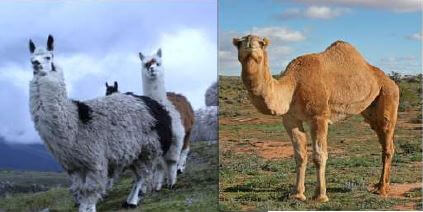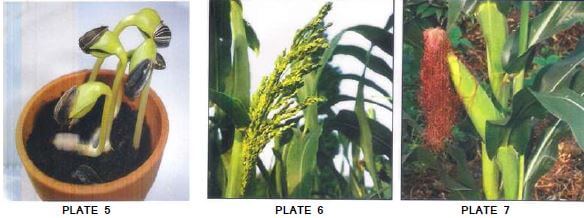Instructions to Candidates:
- Write your name and Index Number in the spaces provided above.
- Sign and write the date of examination in the spaces provided above.
- Answer all questions in the spaces provided in this booklet.
- Candidates should check the question paper to ascertain that all the pages are printed as indicated and that no questions are missing.
- Candidates should answer the questions in English.
QUESTIONS
- You are provided with 250ml beaker, four test tubes, solutions labeled D and E, Iodine and Benedict’s solutions. Half fill the beaker with hot water provided to create a hot water bath.
- Label the four test tubes as follows:
- Test tube 1. D + iodine
- Test tube 2. D + E + iodine
- Test tube 3. D + Benedict’s solution
- Test tube 4. D + E + Benedict’s solution
- Put 1cm3 of solution D in each of the four test tubes.
- To the D + iodine test tube, add one drop iodine solution and shake to mix.
- To the D + E + iodine test tube, add 1cm3 of solution E and two drops of iodine solution
- To the D + Benedict’s solution test tube, add 1cm3 of Benedict’s solution and shake to mix
- To the D + E + Benedict’s solution test tube, add 1cm3 of solution E and 1cm3 Benedict’s solution. Shake to mix.
- Observe the changes in each of the four test tubes
- Put all the four test tubes in the hot water bath and observe carefully for about five minutes
- Record the observations and conclusion for each of the four test tubes in the table below (8marks)
NO TEST TUBE OBSERVATION CONCLUSION 1 D + iodine 2 D + E + iodine 3 D + Benedict’s solution 4 D + E + Benedict’s solution - What was the role of each of the following in the experiment?
- Solution E (1mark)
- Hot water bath (1mark)
- Give the identity of E in human beings (1mark)
- Explain the observations made on the reagents tested with Benedict’s solution (2marks)
- Record the observations and conclusion for each of the four test tubes in the table below (8marks)
- Label the four test tubes as follows:
- The photographs below show organisms that are closely related

- Identify the evidence for organic evolution exhibited by the two organisms above (1mark)
- Observe the two organisms interacting in an ecosystem.
- Identify which of the two animals M and L will have the least biomass (1mark)
- Give a reason for your answer in (b)(i) above (1mark)
- Explain the concept of “Survival for the fittest” in relation to the organisms illustrated in the photograph. (4marks)
- Explain two visible survival adaptive features for the organisms illustrated in the photograph (4mks)
- Study the photographs and answer the following questions.

- The photograph in Plate 5 shows the germination process in a species of legume.
- Name the type of germination shown in the photograph. (1mark)
- Give a reason for your answer. (1 mark)
- Other than germination the seedling have shown some responses.
- Name two responses shown in the photograph. (2 marks)
- State one survival value of each of the response named above. (2 mark)
- Examine the photograph in Plate 6 and Plate 7 which show different essential parts of a flower of a species on two different plants.
- Name the flower parts shown in Plate 6 and Plate 7. (2 marks)
Plate 6.....................................................................................................................................
Plate 7 ...................................................................................................................................
- Name the flower parts shown in Plate 6 and Plate 7. (2 marks)
-
- Name the phenomenon described in the statement above. (1 mark)
- Explain the significance of the phenomena stated in (a)(i) above. (2 mark)
-
- State the mode of pollination of the flower shown in the photograph. (1 mark)
- Give a reason for your answer. (1 mark)
-
- State the type of pollination of the flower shown in the photograph. (1 mark)
- Give two reasons for your answer. (2 marks)
- The photograph in Plate 5 shows the germination process in a species of legume.
MARKING SCHEMES
Question 1
| No | TEST TUBE | OBSERVATION | CONCLUSION |
| 1 | D + iodine | Iodine solution turns blue black | Starch present |
| 2 | D + E + iodine | Turns colourless/brown colour of iodine persists | Starch absent |
| 3 | D + Benedict's solution | Remains blue/no colour change | Reducing sugars absent |
| 4 | D + E + Benedict's solution | Benedict's solution Turns green, uellow | Reducing sugars present |
-
- Breaks down (hydrolyses) starch; into maltose/reducing sugar;
- Provides optimum/suitable temperature; for activity of E/enzymes
- Salivary Amylase/Ptyalin/Amylase/Pancreatic Amylase;
- Substance D tests negative with Benedict’s solution because it is a complex/polysaccharide;
addition of E on heating gives positive results with Benedict’s solution, since E hydrolyses, the starch/complex sugar into simple sugars; testing positive.
OR
Starch in D/D is a non-reducing sugar/complex sugar/polysaccharide/not a reducing sugar;
starch is hydrolysed/digested/broken down into reducing sugars by E/Amylase in E/Amylase/Diastase/enzyme in E
Question 2
- Geographical distribution of living organisms
-
- M
- Animal M is at a higher trophic level than L/M feeds on L/M is a tertiary consumer while
L is a secondary consumer; biomass reduces upwards in a food chain/energy is lost from a lower trophic level to upper trophic level/energy is lost from the producers to the consumers;
- The ecosystem consists of different organisms that compete for resources/struggle to exist;
the well adapted ones survive; perpetuating these traits to the next generation; M is more powerful/stronger/well adapted/more endowed attacks/kills and feeds on L; -
- Both animals/M and L camouflage/blend well with environment ; concealing/hiding themselves from their predators/prey ;
- L covered with scales ; to minimize dessication//protect against sharp objects/stones /thorns mechanical injury/damage ;
- Animal M is stronger/more muscular; to attack/ kill/suffocate/strangle the prey ; (4mks)
Question 3
-
- Epigeal
- cotyledons are above the ground
-
- positive hydrotropism in roots
positive phototropism in shoot. - Phototropism enables plants (shoot) to obtain optimum light for photosynthesis.
Hydrotropism by roots enables plants to absorb water and mineral salts for metabolic processes.
- positive hydrotropism in roots
-
- plate 6 - stamen
plate 7 - pistil
- plate 6 - stamen
-
- Dioecium
- Facilitates pollination leading to variation within the species and increase in hybrid vigour.
-
- Wind pollination
- Small incospicuous bracts; that are dull coloured
-
- cross pollination.
- male and female parts occur in different plants.
The plant pollen grains are sterile to the stigma of the same plant.
CONFIDENTIAL
INSTRUCTIONS TO SCHOOLS
The information contained in this paper is to enable the head of the school and the teacher in charge of Biology to make adequate preparations for this year’s biology practical examination.
NO ONE ELSE should have access to this paper or acquire knowledge of its contents. Great care MUST be taken to ensure that the information herein does not reach the candidates either directly or indirectly.
The teacher in charge of Biology should NOT perform any of the experiments in the same room as the candidates nor make the results of the experiments available to the candidates or give any other information related to the experiments to the candidates.
REQUIREMENTS
Each candidate will require the following:
- 4 test - tubes
- 4ml of solution D
- 4ml of solution E – Diastase solution 10%
- 4ml of Benedict’s solution
- Means of labeling – 4 labels
- Water bath
- Iodine solution
- 4 Droppers
- Means of timing
Solution E
Prepare solution E by dissolving 5g of Enzyme diastase in 500ml distilled water for 125 students
Solution D
Prepare solution D by dissolving 5g of starch powder in 500ml distilled water for 125 students
Download Biology Paper 3 Questions, Answers and Confidential - Lanjet Joint Mock Exams 2022.
Tap Here to Download for 50/-
Get on WhatsApp for 50/-
Why download?
- ✔ To read offline at any time.
- ✔ To Print at your convenience
- ✔ Share Easily with Friends / Students
